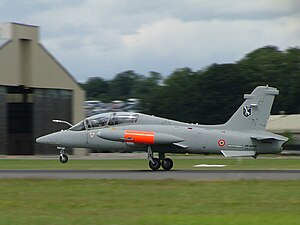Aermacchi MB-339
| MB-339 | |
|---|---|
 |
|
| Role | Advanced trainer and light attack aircraft |
| Manufacturer | Alenia Aermacchi |
| First flight | 12 August 1976 |
| Introduction | 1979 |
| Retired | Royal New Zealand Air Force 2002 |
| Status | Active in production |
| Primary users |
Italian Air Force Royal Malaysian Air Force Eritrean Air Force Nigerian Air Force |
| Produced | 1978–present |
| Number built | 230 |
| Unit cost |
$8.3 million
|
| Developed from | Aermacchi MB-326 |
The Aermacchi MB-339 is an Italian military trainer and light attack aircraft. It was developed as a replacement for the earlier MB-326.
In September 1972, Aermacchi was awarded a contract to study a replacement for the Italian Air Force's MB-326s, comparing seven all-new designs (given the designation MB-338) powered by various engines with an improved version of the MB-326, designated the MB-339. The MB-339 was considered to meet the Italian Air Forces requirements while being cheaper than the all-new designs which resulted in it being selected to replace both the MB-326 and the Fiat G.91T in Italian service.
The MB-339 is of conventional configuration and all-metal construction, and shares much of the 326's airframe. It has a low, un-swept wing with tip tanks and jet intakes in the roots, tricycle undercarriage, and accommodation for the student and instructor in tandem. The most significant revision was a redesign of the forward fuselage to raise the instructor's seat to allow visibility over and past the student pilot's head. The aircraft was fitted with a larger fin and powerplant for the initial versions was the same Rolls-Royce Viper 632-43, producing 4,000 lbf (17.8 kN), as fitted to the MB-326-K.
The first flight took place on 12 August 1976 and deliveries to the Italian Air Force commenced in 1979. It was still in production in 2004 in an enhanced version with a much-modernised cockpit. Over 200 MB-339s have been built, with roughly half of them going to the Italian Air Force.
The Lockheed-Aermacchi MB-339 T-Bird II was a losing contender in the USA's Joint Primary Aircraft Training System (JPATS) aircraft selection. Among the seven to enter, the Raytheon/Pilatus entry won, which became the T-6 Texan II.
According to an article posted on the Italian website 'Il Porto Franci', called 'Armi e finanziamenti nel corno d'Africa', Eritrea paid about $US 50 million for six MB-339 CEs in 1997. This is the original MB-339 with more advanced avionics for the ground attack role, RWR, uprated Viper 680-43 engine, and larger wingtip tanks. It is capable of carrying Sidewinder AAMs, AGM-65 Maverick AGMs, and laser-guided bombs. Unit price of the MB-339C would have to be somewhere around $US 8.3 million dollars in 1997.
...
Wikipedia
